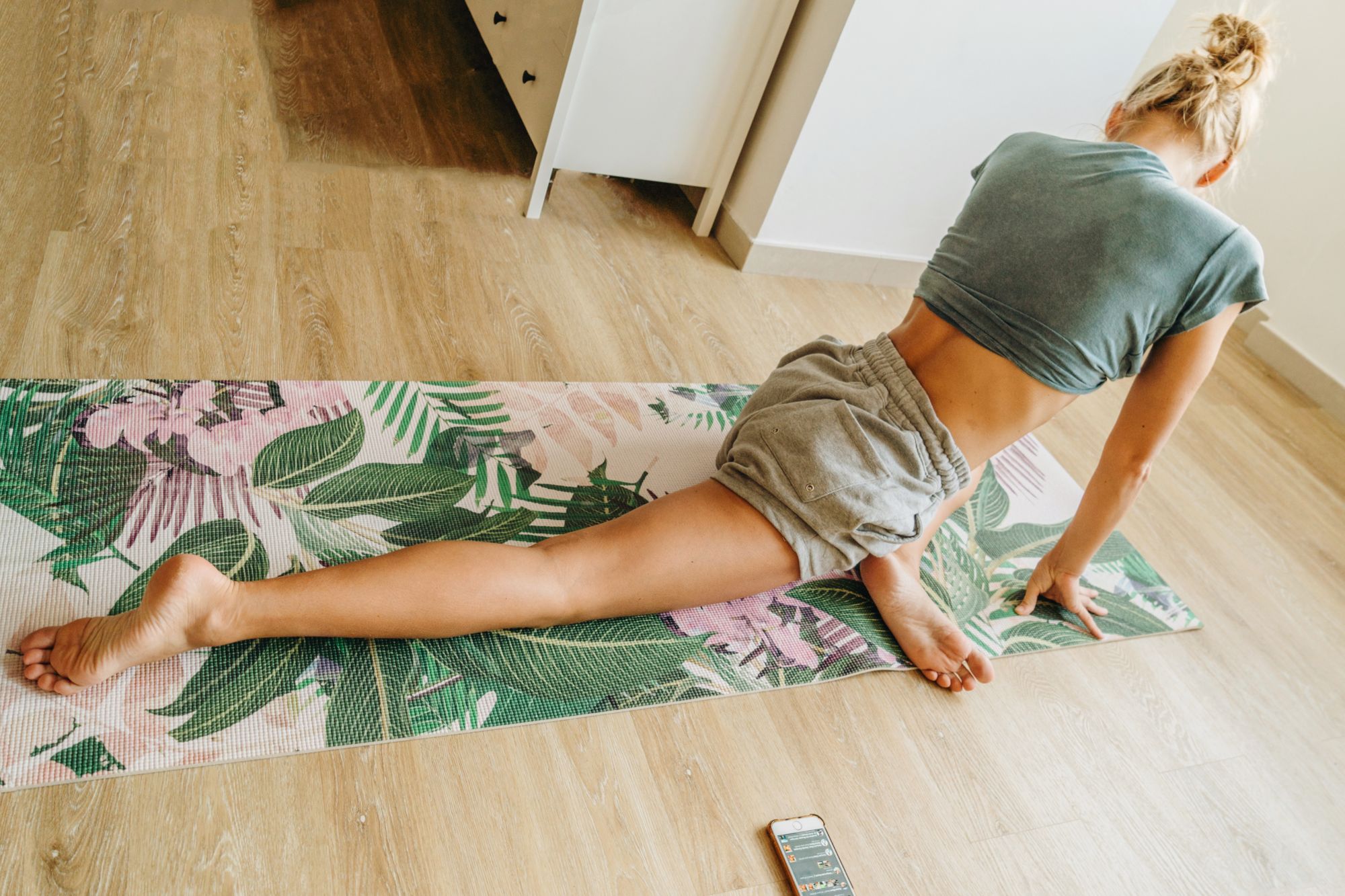What Is Anterior Pelvic Tilt? (And How to Fix It)
The anterior pelvic tilt isn't only aesthetically displeasing but also increases your risk of lifting injuries. Find out how to fix it here.

Do us a favor. Take a look at your standing posture from the side (either sneak a glance of your reflection in a full-length mirror or have someone take a picture of you!) ?
Does something look … well, “off” to you?
Chances are, it's because of something called the "anterior pelvic tilt" – a condition prevalent in individuals who spend long hours sitting (e.g., someone working a desk job).
At this point, you may be asking, “So what?”
Well, first: it isn’t aesthetically pleasing. But perhaps more importantly, this poor posture can cause several painful issues for you over the long term, including hip, knee, and lower back pain.
Not to mention, it also increases your risk of weightlifting injuries.
Alright. No need to panic (unless you’re planning on continued inaction?) for now. The good news is that there are many things you can do to fix your anterior pelvic tilt. Let’s explore.
What is anterior pelvic tilt?
The first step to understanding “anterior pelvic tilt” is to know what “pelvic tilt” refers to.
So, let's start there. And all you need to know is that "pelvic tilt" refers to the positioning of the pelvis in relation to the body.
Since “anterior” means “nearer to the front”, it goes without saying that “anterior pelvic tilt” is when the front of your pelvis rotates forward (which also means the back of the pelvis rotates up).
This then physically manifests in a postural pattern where your:
- Hips are pushed back
- Glutes “stick back” to a greater-than-normal extent
- Abdomen sticks out
… All of which contributes to something like a “Donald Duck” posture – where you have an overly-exaggerated lower back arch (reminiscent of the Hump Day shots women take in the gym).
Causes of anterior pelvic tilt
There are 2 main contributing factors to the development of an anterior pelvic tilt:
- Sedentary lifestyle: As mentioned earlier, the anterior pelvic tilt is commonly observed in individuals who work a desk job. Why? Well, that’s because sitting for prolonged periods can cause the hip flexors to tighten, which "pulls” the pelvic forward. This is made worse by the fact that extended periods of sitting can also cause gluteal amnesia – which means your glutes are no longer able to counter the forward pulling motion of the hip flexors, in turn worsening your anterior pelvic tilt.
- Overtraining certain muscle groups: The unfortunate thing about most abs exercises is that many people end up training their hip flexors instead of their abs. And remember what happens when your hip flexors get too strong? That’s right: anterior pelvic tilt. Worse still, many people don't know how to properly activate their glute muscles in the gym – which, imaginably, then contributes to a more anteriorly tilted pelvis.
At its core, though, anterior pelvic tilt comes down to 2 words: “muscular imbalances”. More specifically:
- Weakened muscles: Abs and the glutes
- Over-active muscles: Hip flexor muscles
How to fix anterior pelvic tilt
So … what’s the fix for anterior pelvic tilt? It’s pretty straightforward: by addressing the muscular imbalances.
That means strengthening the weakened muscles (i.e., abs and glutes) and “stretching out” the over-active muscles (i.e., hip flexor muscles).
Here are a few exercises that’ll help you do exactly that – so you can get your pelvis back into a pain-free neutral position.
Exercise #1: Pigeon stretch
First, we’re going to work on your overly tight hip flexors. And there’s arguably no better stretch that’ll help you open your hips than the pigeon stretch.
To perform the pigeon stretch:
- Find yourself a couch or any elevated platform
- Cross your front leg on top of it and fully extend your back leg; this helps “lengthen out” your hip flexor
- Place your hands on your foot and knee – and brace your core
- Bend at your hips to bring your chest forward until you feel a stretch in the side of your front hip
- Switch to the other side, and repeat steps 1 through 4
Exercise #2: Lying pelvic tilts
Something that’ll help you counter the forward pulling action of your hip flexors is an exercise called the “lying pelvic tilts”.
This is where you learn how to do the posterior pelvic tilt – i.e., the exact opposite of an anterior pelvic tilt.
Knowing how to perform the posterior pelvic tilt is essential as it'll reinforce proper movement patterns in many of your lifts in the gym (which would also help you activate muscle groups you want to).
To perform the lying pelvic tilts:
- Lie on your back with your knees flexed and pointed upwards
- Flatten your lower back to minimize the gap between your body and the ground; you’ll have to tilt your pelvis before this can happen
And … congratulations! You have successfully achieved a posterior pelvic tilt!
Exercise #3: Glute bridges
Now that you know how to get into a posterior pelvic tilt and your hip flexors are nice and “loose”, we’re going to work on strengthening your glutes.
But, of course, you’d struggle to do that if you can’t even activate your glutes in the first place. That’s why we’re going to help you build that much-needed “mind-muscle connection” with glute bridges.
This will get you familiar with what your glutes are supposed to feel when they're contracting hard during an exercise.
And to perform the glute bridges:
- Lay on your back with your knees bent and feet flat on the floor
- Move into your posterior pelvic tilt position (as you did in the lying pelvic tilts exercise) by contracting your glutes and abs
- Use your glutes to thrust your hips in the air; make sure you don’t arch your back at the end range
- Hold the top position for a moment before coming back down for more reps
And once you're able to contract your glutes "at-will", well, you're free to move on to some of the more complicated (but also much more effective) glute exercises around – including barbell hip thrusts and the Romanian deadlifts.
Exercise 4: RKC planks
Finally, we’re going to want to strengthen your abs. And one of the best exercises that’ll help you do that is the RKC plank (because it’s near impossible for you to activate your hip flexors instead of your abs here).
To perform it:
- Set up as you would in a standard plank, but with your hands interlocked and your feet slightly wider than shoulder-width apart
- Activate your abs by consciously attempting to draw your belly button towards your spine
- Posteriorly tilt your hips and continue to contract as you hold the plank
- Hold this position for as long as possible – all the while ensuring that you’re not allowing your lower back to arch
By the way: check out this article for more abs exercises!
Re-assess your posture from time to time
After you've incorporated the above exercises into your routine, be sure to re-assess your posture regularly – so that you know you're on the right track.
And in the meantime, you also need to develop your muscles in a well-balanced manner (i.e., hitting all muscle groups with equivalent volume and attention). This prevents you from dealing with the hassle of fixing your muscle imbalances in the first place.
Don’t know how you can do that?
Well, you don’t have to do everything yourself. Just leave the programming to GymStreak, an AI-powered personal trainer app that’ll take care of your workout programming – so you don’t have to. Sounds good? Thought so.
Get GymStreakReferences
Baker, R., Coenen, P., Howie, E., Williamson, A., & Straker, L. (2018). The Short Term Musculoskeletal and Cognitive Effects of Prolonged Sitting During Office Computer Work. International Journal of Environmental Research and Public Health, 15(8), 1678. https://doi.org/10.3390/ijerph15081678
Buckthorpe, M., Stride, M., & Villa, F. D. (2019). ASSESSING AND TREATING GLUTEUS MAXIMUS WEAKNESS – A CLINICAL COMMENTARY. International Journal of Sports Physical Therapy, 14(4), 655–669.
Falk Brekke, A., Overgaard, S., Hróbjartsson, A., & Holsgaard-Larsen, A. (2020). Non-surgical interventions for excessive anterior pelvic tilt in symptomatic and non-symptomatic adults: A systematic review. EFORT Open Reviews, 5(1), 37–45. https://doi.org/10.1302/2058-5241.5.190017
Minicozzi, S. J., Russell, B. S., Ray, K. J., Struebing, A. Y., & Owens, E. F. (2016). Low Back Pain Response to Pelvic Tilt Position: An Observational Study of Chiropractic Patients. Journal of Chiropractic Medicine, 15(1), 27–34. https://doi.org/10.1016/j.jcm.2016.02.009
Nation, B. C., T. (2010, May 17). Inside the Muscles: Best Ab Exercises. T NATION. https://www.t-nation.com/training/inside-the-muscles-best-ab-exercises/
Waryasz, G. R. (2010). Exercise Strategies to Prevent the Development of the Anterior Pelvic Tilt: Implications for Possible Prevention of Sports Hernias and Osteitis Pubis. Strength & Conditioning Journal, 32(4), 56–65. https://doi.org/10.1519/SSC.0b013e3181d58aac

